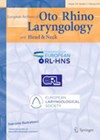You searched for "invasive"
Invasive differentiated thyroid cancer
1 November 2016
| Serge Latis
The majority of patients presenting with differentiated thyroid cancer have early small disease with excellent long-term outcomes. However, aerodigestive tract invasion is reported in around 10% of case series and is a poor prognostic factor. This article has been authored...
The medially-invasive cholesteatoma: a case series
4 May 2021
| Lucy Dalton
|
Neurotology, Otology, ENTA - Skull Base Surgery
|
cholesteatoma, chronic ear disease, skull base surgery, transcochlear, translabyrinthine
In this small case series, Casazza et al describe their management of seven cases of complex cholesteatoma presenting during a 16-year period. Patients were included if imaging confirmed restricted diffusion and an endophytic, medially-destructive disease involving the otic capsule, petrous...
Diagnostic features of acute invasive fungal sinusitis
6 January 2023
| Christopher Burgess
|
ENTA - Rhinology / Sinus
|
Acute invasive fungal sinusitis, Neutropenia, Platelets
Acute invasive fungal sinusitis (AIFS) is a rare but frequently lethal condition, commonly associated with a high morbidity among those that survive. It has gained recent media attention on account of its increased incidence following infection with (and treatment for)...
Minimally invasive techniques for benign salivary gland obstruction
Salivary gland obstruction is a common condition – it is recognised by a complaint of intermittent meal-time swelling of the affected salivary gland and can be accompanied by recurrent infections. Imaging can identify the nature and location of an obstruction...Rapid, non-invasive and differential diagnosis of laryngopharyngeal reflux
20 January 2022
|
Company Profiles, Research & Development
Laryngopharyngeal reflux (LPR) is a significant condition that frequently goes undiagnosed at a primary care level, resulting in patients being unnecessarily referred to secondary care with symptoms such as a sore throat, persistent cough, vocal problems and issues with swallowing.
Vestibular function preservation after minimally invasive paediatric cochlear implantation
3 May 2024
| Gauri Mankekar
|
ENTA - Auditory Implants, Otology, Paediatric ENT, ENTA - Vestibular Disorders
This retrospective study analysed results in 24 paediatric patients with low-frequency residual hearing before and after minimally invasive cochlear implantation. The authors define minimally invasive cochlear implantation as a round window insertion of flexible Nucleus CI422, Nucleus CI522, MedEl Flex...
Minimally invasive surgery vs. linear incision for BAHA – outcomes compared at six months
The postoperative outcomes which are clinically relevant now in bone anchored hearing device surgery have come a long way over the past decade. The newer techniques have meant that previous concerns with skin numbness and cosmesis are now such rare...Does minimally invasive surgery under local anaesthesia have a role in the management of chronic rhinusinusitis?
2 November 2020
| Madhup K Chaurasia
|
ENTA - Rhinology / Sinus
|
Anesthesia, Elderly, Nasal Polyps, Sinusitis, Surgery
A formal FESS procedure usually done under local anaesthesia is considered as gold standard in the management of chronic rhinusinusitis. However, success is hampered by a significant recurrence rate of polyps requiring revision surgery, long waiting lists, reluctance of elderly...
Tactile Sensing and Displays: Haptic Feedback for Minimally Invasive Surgery and Robotics
1 January 2014
| B Nirmal Kumar (Prof)
|
ENTA - ENT
This book has a catchy title and due to my interest in developing simulation systems for training in surgery I was delighted to be asked to review. However, I found it very hard going and the first few chapters are...
Suspect the unsuspecting in thyroid cancer
1 July 2018
| Suzanne Jervis
|
Thyroid cancer, Invasive thyroid cancer, Aerodigestive tract invasion
This article reminds readers of how often invasive thyroid disease can appear, as the symptomatology is minimal. Noticeable airway symptoms appear after 50% of the airway is involved and surgeons can often fall in the unsuspecting trap of discovering locally...
Is bone scanning still of value?
1 September 2019
| Stuart Clark
|
ENTA - Head & Neck
|
bone invasion, computed tomography, magnetic resonance imaging, oral, squamous cell carcinoma
This is an article from Australia of 109 patients, 83 of which had CT, 72 MRI and the presence of bone invasion on imaging was compared with the histopathology. Bone invasion was present in 44 of 109 resection specimens. Bone...
Landmark study at Homerton University Hospital confirms GastroPanel®’s diagnostic accuracy
26 February 2025
|
Research & Development
BIOHIT HealthCare is pleased to announce that a clinical study conducted by Homerton University Hospital NHS Foundation Trust, London, has confirmed the diagnostic accuracy of GastroPanel in identifying gastric cancer risk in patients with upper abdominal complaints. This study demonstrated...












